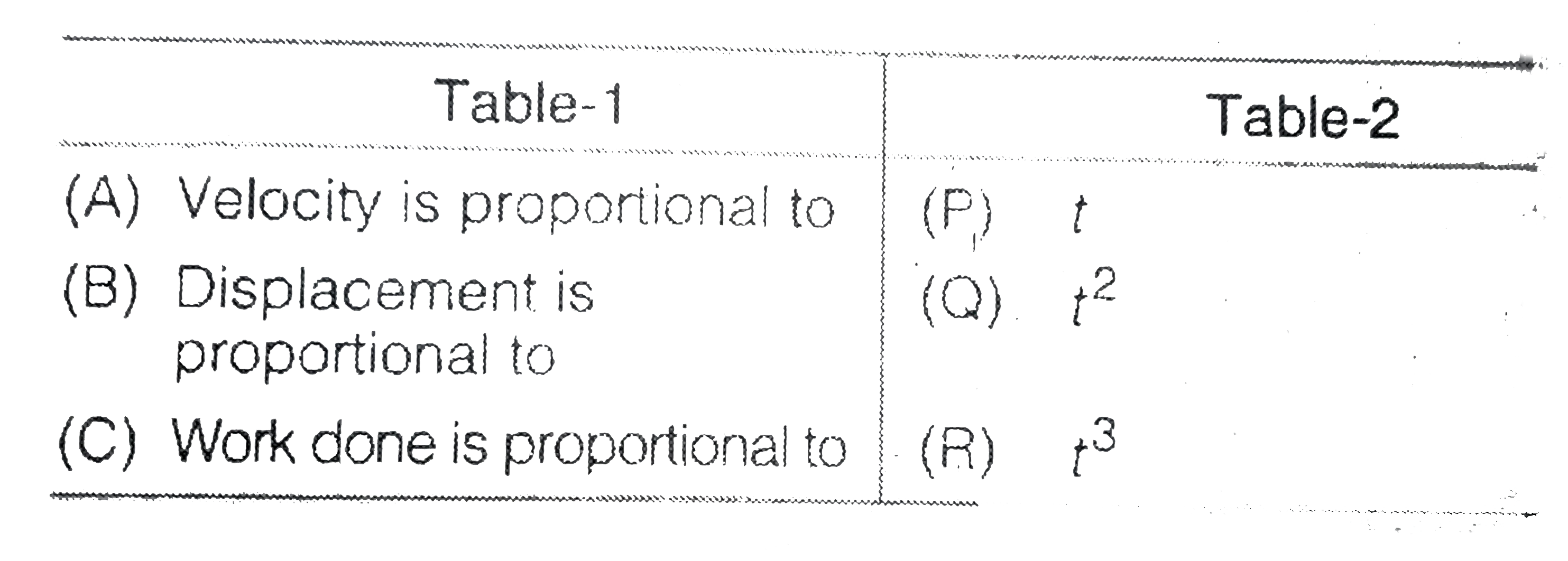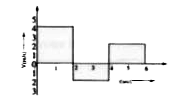A body is moved along a straight line by a machine delivering constant power . The distance moved by the body is time t is proptional to
t1/2
t3/4
t3/2
t2
The correct Answer is:C
To solve the problem, we need to determine how the distance moved by a body, when moved by a machine delivering constant power, is related to time t. Let's go through the solution step by step.
Step 1: Understand the relationship between power, work, and time
Power P is defined as the rate at which work is done. Mathematically, this can be expressed as:
P=Wt
where W is the work done and t is the time taken. Rearranging this gives us:
W=P⋅t
Step 2: Apply the work-energy theorem
According to the work-energy theorem, the work done on an object is equal to the change in its kinetic energy. If we assume the object starts from rest, the work done can be expressed as:
W=ΔKE=12mv2
where m is the mass of the object and v is its final velocity.
Step 3: Equate the two expressions for work
From Step 1, we have:
W=P⋅t
From Step 2, we have:
W=12mv2
Setting these two expressions for work equal to each other gives:
P⋅t=12mv2
Step 4: Solve for velocity v
Rearranging the equation to solve for v2:
v2=2Ptm
Taking the square root gives us the velocity:
v=√2Ptm
Step 5: Relate velocity to displacement
Velocity v is defined as the rate of change of displacement s with respect to time t:
v=dsdt
Substituting the expression for v from Step 4:
dsdt=√2Ptm
Step 6: Separate variables and integrate
To find displacement s, we can separate the variables:
ds=√2Pm⋅√tdt
Now, we integrate both sides:
s=∫ds=√2Pm∫√tdt
The integral of √t is:
∫√tdt=23t3/2+C
Thus, we have:
s=√2Pm⋅23t3/2+C
Step 7: Conclude the relationship
Ignoring the constant of integration (since we are interested in the proportionality), we find that:
s∝t3/2
This means that the distance moved by the body is proportional to t3/2.
Final Answer
The distance moved by the body is proportional to t3/2.
---
Power P is defined as the rate at which work is done. Mathematically, this can be expressed as:
P=Wt
where W is the work done and t is the time taken. Rearranging this gives us:
W=P⋅t
According to the work-energy theorem, the work done on an object is equal to the change in its kinetic energy. If we assume the object starts from rest, the work done can be expressed as:
W=ΔKE=12mv2
where m is the mass of the object and v is its final velocity.
From Step 1, we have:
W=P⋅t
From Step 2, we have:
W=12mv2
Setting these two expressions for work equal to each other gives:
P⋅t=12mv2
Rearranging the equation to solve for v2:
v2=2Ptm
Taking the square root gives us the velocity:
v=√2Ptm
Velocity v is defined as the rate of change of displacement s with respect to time t:
v=dsdt
Substituting the expression for v from Step 4:
dsdt=√2Ptm
To find displacement s, we can separate the variables:
ds=√2Pm⋅√tdt
Now, we integrate both sides:
s=∫ds=√2Pm∫√tdt
The integral of √t is:
∫√tdt=23t3/2+C
Thus, we have:
s=√2Pm⋅23t3/2+C
Ignoring the constant of integration (since we are interested in the proportionality), we find that:
s∝t3/2
This means that the distance moved by the body is proportional to t3/2.
The distance moved by the body is proportional to t3/2.
Topper's Solved these Questions
- WORK, POWER AND ENERGYBook:DC PANDEY ENGLISHChapter:WORK, POWER AND ENERGYExercise:A Only One Option is Correct
Explore 42 Videos
- WORK, POWER AND ENERGYBook:DC PANDEY ENGLISHChapter:WORK, POWER AND ENERGYExercise:B More than One Option is Correct
Explore 26 Videos
- WORK, ENERGY AND POWERBook:DC PANDEY ENGLISHChapter:WORK, ENERGY AND POWERExercise:MEDICAL ENTRACES GALLERY
Explore 33 Videos
Similar Questions
A body is moved from rest along a straight line by a machine delivering constant power. The ratio of displacement and velocity (s/v) varies with time t as
View SolutionA body is moved from rest along a straight line by a machine delivering constant power. The ratio of displacement and velocity (s/v) varies with time t as
View SolutionA body is moved along a straight line by a machine delivering a power proportional to time (P∝t). Then, match the following.

View SolutionA machine is delivering constant power to drive a body along a straight line. What is the relation between the distance travelled by the body against time ?
View SolutionA motor drives a body along a straight line with a constant force. The power P developed by the motor must vary with time t as
View SolutionThe initial velocity of a body moving along a straight lines is 7m/s. It has a uniform acceleration of 4m/s2 the distance covered by the body in the 5th second of its motion is-
View SolutionThe velocity of a body moving in a straight line is increased by applying a constant force F, for some distance in the direction of the motion. Prove that the increase in the kinetic energy of the body is equal to the work done by the force on the body.
View SolutionA body of mass 2 kg is driven by an engine delivering a constant power of 1 J /s. The body starts from rest and moves in a straight line. After 9 seconds, the body has moved a distance ( in m) ……….. .
View SolutionThe velocity time graph of a body moving in a straight line is shown in the figure. The displacement and distance travelled by the body in 6 sec are respectively.

View SolutionA body starting from rest moves along a straight line with a constant acceleration. The variation of speed (v) with distance (s) is represented by the graph:
View Solution